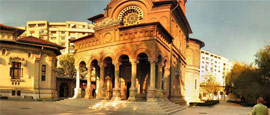Said to be the world’s second largest administrative building (after the Pentagon) and the heaviest, this vast Palace of the Parliament gave life in 1984 and is known for its ornate interior composed of 23 sections, including the Senate and Romania's National Museum of Contemporary Art. Guided tour offers fascinating insights into the mindset of the times. Entry by guided tour only and must bring your passport for ID check. Call to book at 40 733 558 102 / 103.
Things to see in Bucharest
Tourist offices
Address: Bulevardul Dinicu Golescu, Bucharest, Romania
Tel: +40 372 144 079
Opening Hours:
Mon-Thurs 0830-1700, Fri 0830-1430.
www.romania.travelThe narrow cobblestone streets between Calea Victoriei and Bulevardul Hristo Botev is Bucharest's Old Town, or Old Centre, an area that wasn't demolished by Nicolae Ceauşescu. Much of the area has been renovated and now packed with trendy coffee houses and restaurants - most lively when they spill onto the cobbled streets (or overtake empty lots) during summer. At its heart is the 15th-century Curtea Veche (Old Court), attributed to Vlad Tepes, which contains a few walls, arches, tombstones and one restored Corinthian column. Not far from there is the lovely Stavropoleos Church with painted frescoes and an ornately carved iconostasis.
Not far from the Old Town is the Jewish Neighbourhood of Bucharest which houses a small community of Jewish population, a cultural centre, a museum and a few working (as well as abandoned) synagogues. It is best to join a walking tour and learn about the sorrowful history of the Jews in Romania.
Although tragically vandalised and looted during the 1989 uprising, the museum (inside the one-time Royal Palace, built in 1812) has now been lovingly restored. Its European Art Gallery is an absolute treasure, containing many rarely seen masterworks. Highlights include Von Eyck's Crucifixion and a Rembrandt. On every Tuesday, the museum also opens the former royal living quarters to visitors. Guided tours in English can be organised in advance by contacting the museum. See the website for more info.
Down an unassuming boulevard in the wealthy Dorobanti district of Bucharest, Palatul Primaverii (Spring Palace) is the former home of communist dictator Nicolae Ceausescu and his wife Elena, who lived there for the last 25 years of their lives, before their execution in 1989. Opened to the public in March 2016, the house shows the opulent surroundings the couple lived in while much of the country subsisted on rations. Carpets given by the last Shah of Iran, paintings taken from the country’s former royal palaces, and rooms done up in the style of Versailles hardly attest to a couple in touch with the lives of the common man. The palace remains largely untouched since the 1989 revolution, even down to the couple’s wardrobes and pyjamas lying on their bed, enabling visitors to get a real glimpse into the lives of the former first couple.
Just north of the Old Town, this was the site where in 1989, about 100,000 men and women bought in to cheer for former leader Nicolae Ceaușescu turned to taunt him, and the jeers soon erupted into a riot. Now the Memorial of Rebirth, a 25-metre-high obelisk, stands tall. The Memorial commemorates the victims of the Romanian Revolution but its design has sparked controversy and it remains unpopular. Surrounding buildings include the ornate Atheneum concert hall and the National Museum of Art of Romania. Nearby, there are several excellent galleries and smaller museums.
Nearly obscured by 1970s housing blocks, this ornate 17th-century cathedral, situated on a small hill overlooking the grey communist-built Piata Unirii, is the headquarters of the Romanian Orthodox Church. A fabulous fresco of the blessed and the damned, ascending to heaven or tumbling into hell, adorns the entrance, as well as the oldest icon on the site, depicting patron saints Constantin and Helen (1665). Inside, expressive and beautifully painted icons, embedded in an exquisite gilded altarpiece, dazzle the eye in the sombre darkness. St Dumitru, Bucharest's patron saint, lies entombed in the left-hand corner and worshippers constantly climb the small staircase to his shrine to pay their respects.
Over a hundred peasant homes, barns, churches and mills, representing vernacular rural architecture, were transported from all over Romania to a park on the west side of Herastrau Lake in north Bucharest. Built to show the pride of Romanian peasants in their work and homes, highlights of this open-air museum include a wooden church from the Maramureş region of norther Transylvania and the very charming thatch-roofed house of Dumitra. Many houses contain everyday accessories such as tools, butter-churns, hay forks, beer kegs and clothes. Occasionally the museum also hosts folkloric and traditional crafts festivals.
The Armenian collector, Krikor Zambaccian, bequeathed his intimate collection of mostly impressionist paintings (including one of Constantin Brancusi's earliest sculptures) to the Romanian state in 1946, along with his beautiful residence. The Romanian collection is small, but selective, with great works by some of the country's best-known masters. By the time you leave, names like Nicolae Grigorescu and Stefan Luchian seem slightly less foreign. The small collection of works by Picasso, Cezanne, Bonnard and Renoir is situated on the top floor. The museum is now part of the National Art Museum.
Do you have any Feedback about this page?
© 2025 Columbus Travel Media Ltd. All rights reserved. No part of this site may be reproduced without our written permission, click here for information on Columbus Content Solutions.








 You know where
You know where